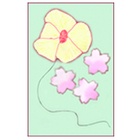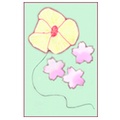The "being half" experience, specifically for Japanese and white American mixes, vary. Some are more Japanese than others. Some are more white/American than others. Some are a good mix of both. I have friends who fit under each category. I’m a good mix of both and more because I grew up in Southern California in predominantly Mexican neighborhoods. I was fortunate enough to be strongly connected to the cultural traditions of my ethnic heritages including the strong Mexican culture that pervaded the neighborhoods I lived in. But even the good mixes have identity crises over disconnection from their ethnic roots and lack of cultural experience.
Weekend excursions to Little Tokyo with my mother in the ‘80s and early ‘90s were a natural part of my childhood. Identity was not an issue for me or my kindergarten classmates. Most of my classmates and friends were second generation Mexicans, a few of them Filipino and Chinese. We didn’t care about where we were born or what our family genealogy was. And we sure didn’t expect to have to care when we got older.
Looking Japanese didn’t become a concern for me until I was 10 years old. It started with my fourth grade classmates. They started to form their own social cliques with ethnicity as grounds for being permitted to the group. By the fourth grade, we no longer hung out with each other. It must’ve been decided during the summer before fourth grade because seeing the groups set in place was a surprise to me. I didn’t know which group to join because I had friends in all of them. I wasn’t the exclusive type. I wanted to hang out with all of my friends together. The Mexican group welcomed me with open arms because I looked the part, but I didn’t feel authentic enough to join because I wasn’t Mexican. The Asian group was more exclusive. If one did not look Asian, he or she could not join. I was ok with it, but did feel frustrated with the ridiculous complexity of my classmates’ logic. They equated “real” friends according to ethnicity and fashion. Part of me understood the unspoken sense of brotherhood people feel when they are with people they can relate to. What I didn’t understand was why our friendships dissolved so quickly.
I was never confused about my biological and cultural identity, but there were many moments growing up when I wished I was a Christian Mexican. I was the only one at school who didn’t go to church on Sundays or have cousins who lived in the same neighborhood. I felt left out. I did have a lot of second-generation Japanese American friends growing up, though. All of them were family friends and friends I made in my Buddhist church band. I saw them regularly on the weekends and in the summer. There were several half Japanese half white kids in my church band but the full-blooded Japanese Americans outnumbered us half-breeds. No one was mean to each other but there was a subtle air of exclusiveness from the full-blooded Japanese Americans when a group of them were together. They would speak in Japanese loudly so that those who didn’t understand would hear. It felt as though they were going out of their way to make those who weren’t Japanese or looked it, feel not Japanese enough.
During the week at school and at home, I was the only white (and unrecognizably Japanese) person in my predominantly Mexican neighborhood who kind of fit in because I was a brunette and didn’t look Asian. I had more leeway in manipulating my identity, especially in high school. My unusually fair skin singled me out, but not enough to have my own ethnic label. At the bus stop after school, elderly women would ask me in Spanish when the next bus was supposed to come. I’d respond as best I could in my broken Spanish and they would look at me strange, their expectations suddenly lowered because their grandkids can’t speak proper Spanish. I was accepted as the unusually fair-skinned Hispanic girl. When my classmates and teachers learned that I was half Japanese, it drew attention. I was white, Japanese, and looked Hispanic enough amongst my peers to communicate with them without being judged. The true benefit, looking back, was that I was able to demystify the many stereotypes my Mexican American counterparts at my high school had of all Asians being Chinese and good at math. If I looked Asian, I know I would have had a harder time.
Thankfully, my only identity crisis was of teen angst and “finding myself” in college. It was in college that I met people from all over the world with distinct experiences. I learned the meaning and beauty of diversity and began to embrace my own. For the first time, I felt proud of and completely comfortable with my humble beginnings and identity as a work in progress.
My “being half” no longer feels like something someone else owns. I don’t mind the vocabulary as much either.
© 2006 Victoria Kraus




